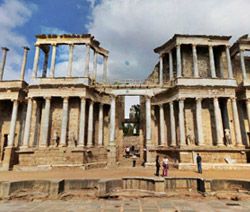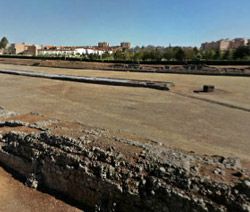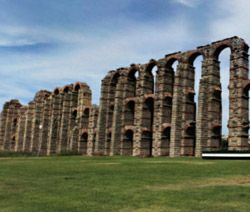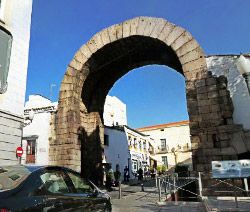Visit Mérida
- Mérida local guide: businesses, leisure, services and sightseeing. http://guiamerida.es/
- Mérida Tourism. http://turismomerida.org/inicio/
- Consorcio Ciudad Monumental de Mérida: Gestora para la conservación, restauración y acrecentamiento de la riqueza arqueológica y monumental. http://www.consorciomerida.org/
- International Classical Theatre Festival in Mérida. http://www.festivaldemerida.es/
- Stone & Music festival. https://stoneandmusicfestival.com/
- Mérida Town Hall. http://merida.es/
- Tourism of Extremadura. http://www.turismoextremadura.com/

Thus begins a period of great splendour whose proof we can witness in its magnificent buildings: the theatre, the amphitheatre, the circus, temples, bridges and aqueducts.
For centuries and until the fall of Western Roman Empire, it was a major merida legal, economic, military and cultural center, and one of the most prosperous towns in the Roman era, categorized ninth among the most prominent of the Empire (even ahead of Athens) by Ausonious. In the third century it became the capital of the diocese Hispaniarum.
Roman Theatre
The Roman theater in Merida is a construction promoted by consul Marco Vipsanio Agrippa in the Roman town of Augusta Emerita, current Mérida (Spain). Thanks to a date inscribed in the very theater we know that it was built in the years 15 to 16 BC. The theater has undergone several renovations, the most important one in between late first century and early second century, possibly during the reign of Emperor Trajan. The currnte front façade or scene was raised. Another renovation was held in time of Constantine (between 330 and 340 AD), with new-decorative architectural elements and a walkway around the monument. Following the abandonment led by Christianity because of the immorality of the theater, it is abandoned and covered with earth, leaving visible only the upper tiers of seats (summa cavea). Popular imagination called it “las Siete Sillas” (the seven chairs), where tradition says several Moorish kings sat to decide the city’s fate.
Theater located at the archaeological site of Merida, one of the largest archaeological sites in Spain. It was declared World Heritage by UNESCO in 1993. The theater was located within the Roman city in a peripheral location, next to the walls, part of the tiers leaning on St Albin hill.
Roman Anphitheater
The amphitheater is part of the archaeological site of Merida, one of the largest and most extensive archaeological sites in Spain. It was declared World Heritage by UNESCO in 1993.
The Roman Anphitheater was built in Mérida. The town was founded in 25 B.C. named Augusta Emerita by Octavius Augustus, it was a retirement place for Roman army soldiers from two veteran legions of the Cantabrian Wars: Legio V Alaudae and Legio X Gemina. These legions were situated under condition of upgrading the ancient inhabitants to the category of Roman citizens. The city was the capital of the Roman province of Lusitania. “Emeritus” stands for “retired” in Latin and it referred to the soldiers retired with honor.
Roman Circus

Its construction was begun in the early years of the first century (year 20 AD), during the time of Tiberius. Along with the amphitheater of Merida, it was the largest of the entertainment buildings of shows in the city.
Roman Circus located at the archaeological site of Merida, one of the largest archaeological sites in Spain. It was declared World Heritage by UNESCO in 1993.
Roman Bridge over River Guadiana
It can somehow be considered as the city origin, as well as it marks the path as to be the extension of one of the main streets of the colony: the Decumanus Maximus.
The situation of the bridge is carefully selected at a ford of river Guadiana offering a central island that divides it into two channels. The original structure did not provide the continuity of the present, as it was composed by two sections of arches joined in the island. In Roman times its length was extended several times, adding at least five portions of consecutive arcs so that the road did not close during the periodic flooding of the Guadiana. That has caused this work to reach 792 m long, one of the largest bridges remaining from that time.
Aqueduct of Los Milagros

It is commonly known by this name, because it seems miraculous that it remains standing.
Aqueduct of Rabo de Buey – San Lázaro
The Aqueduct of Rabo de Buey – San Lázaro (Oxtail – San Lazaro) carried water water from streams and underground springs located north of the city.
The underground driving is well preserved unlike the archery built to save valley Albarregas. Only three pillars and their arches next the Roman circus monument and other sixteenth-century aqueduct still remain. Its materials were used to build another aqueduct in XVI century.
Diana Temple
This building used to belong to the municipal forum of the city. It is one of the few religious buildings that remains in satisfactory condition. Despite wrongly assigned name in its discovery, the building was dedicated to imperial cult. It was built in the late first century BC or early AD, in the Augustan age.
The building is rectangular, surrounded by columns. Its facade was facing the forum and was formed by a set of six columns ending in a gable. The current preservation of the building is due to having been incorporated into the Count of Corbos Renaissance palace, whose remains can still be seen in the hall inside the temple. Granitic materials were mainly used in its construction..
Trajan´s Arch

It is made of granite, and covered in marble in its origins. It measures 13.97 meters high, 5.70 m wide and 8.67 m for arc flash. It is believed to have a triumphal character, although it could also have served as a prelude to the Foro Provincial. Surrounded by modern constructions and neighboring houses, this arch stands majestic and is admired by travelers and historians of all time. Its name is arbitrary because the commemorative inscription was lost centuries ago.
Mitreo House
The mithraeum house was found by chance in the early 1960’s. It is located on the southern slope of Mount St. Albin. Its current name comes from the proximity to the area where the mithraeum is supposed to have been. The whole mansion was built in masonry witch concrete blocks on the corners. It highlights the peristyle with an indoor and a in western sector room the famous cosmogonic mosaic. It consists of an allegorical representation of the elements of nature (rivers, winds, etc) chaired by the figure of Aion. The complex has recently been roofed and fitted out
Columbaria
Under that name two funeral buildings are known. They are held in the open, outside the walls of the ancient Roman city. Both of them are the best example of funerary constructions in Emerita. Materials used are masonry and granite masonry. In the two sections identification of the owner families (the vaconios and Joules) are preserved so it has been possible to know the origin and condition of them.
Arab Fortress
Near the Roman bridge over River Guadiana River. It was built by Abderraman II in 835 AD as a stronghold to control the city, which since 805 had rebelled against the continuous Emirate rule. First Arab fortress of the Iberian Peninsula.
It is a complex construction, consisting of a large square area of 130 square on a side, capable of hosting a large number of troops. Inside there is a beautiful tank, consisting of an endless water tank (filtered from Guadiana) that was accessed through a double corridor underground a tower. A convent for the Order of Santiago was built on one edge and is now the headquarters office of the Junta de Extremadura. Another smaller place called “alcazarejo” (little fortress) is attached next to the Roman bridge, which controlled the river crossing towards the city.

 Español
Español